Roaches
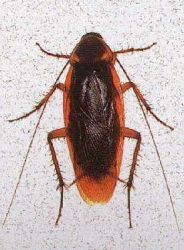 Description: About one and one-half inches long with red-to-brown wings and lighter marking along the thorax.
Description: About one and one-half inches long with red-to-brown wings and lighter marking along the thorax.Habitat: This cockroach is a common inhabitant of sewage systems and basements. The American cockroach is found most commonly in restaurants, grocery stores, bakeries, and where food is prepared or stored. During the summer months, alley ways and yards may be badly infested.
Life Cycle: Egg capsules are often glued to surfaces and are often covered with paint or other building material. The incubation period is 38-49 days, and the number of egg cases produced by the female is from 6 to 14, with an average of 9.5. A female may produce 30-90 egg capsules at intervals of approximately 4-7 days. The egg capsule may contain up to 16 eggs. The whitish, newly-emerged nymphs begin to run around actively in about 10 minutes. The first few molts of the nymph occur at approximately monthly intervals, but thereafter may vary from 1 to 6 months. The American cockroach molts 13 times before reaching maturity.
Brownbanded Cockroach
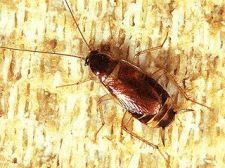 Description: Approximately 5/8 of an inch long with yellowish-brown banding on the wings.
Description: Approximately 5/8 of an inch long with yellowish-brown banding on the wings.
Habitat: Brown-banded cockroaches are found in homes, apartments, hotels, and hospitals. They are less frequently found in stores restaurants and kitchens. They are frequently transported in furniture and will spread rapidly through an entire building. Brown-banded cockroaches are generally found on ceilings, high on walls, behind picture frames, and near motors of refrigerators and other appliances. They are also found in light switches, closets and furniture. They do not require as much moisture as the German cockroach which explains why they normally are found in rooms other than the kitchen or bathroom. These cockroaches dislike light and are not normally seen during the day.
Life Cycle: The life cycle of the brown-banded cockroach takes an average of 161 days. The males have a shorter development period than the female. The egg capsule is yellowish or reddish/brown in color and is 3/16 inch (5 mm) in length. The female carries the egg capsule for 24 to 36 hours and then attaches it to some object. Egg capsules may be glued to desks, tables and other furniture, and even in bedding. This habit of hiding capsules in furniture probably accounts for its spread. The maximum number of eggs to be found in a capsule was 18. The flattened virgin female develops an enormously enlarged abdomen when she becomes gravid. The average incubation period is 69.7 days. The females produce a greater number of capsules during the summer.
German Cockroach
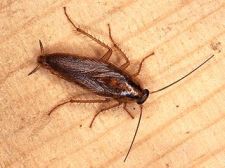 Description: Approximately 5/8 of an inch long and medium-to light brown color. The thorax will have dark long streaks.
Description: Approximately 5/8 of an inch long and medium-to light brown color. The thorax will have dark long streaks.
Habitat: It is the most prevalent species in and around homes, apartments, supermarkets, food processing plants, and restaurants. During the day in houses, they hide in cracks and crevices such as under kitchen appliances, sinks cabinets, behind baseboards and moldings, in wall voids, pantries and similar areas of homes and restaurants. In commercial establishments such as food plants, warehouses, supermarkets, etc, they can be found in cardboard containers, wooden boxes, and under pallets.
Life Cycle: The German cockroach breeds throughout the year indoors, but favors a humid environment and an average temperature of approximately 80°F. A life cycle can be completed in about 3 months. The German cockroach produces more eggs per capsule than other pest cockroach species, and its young complete their growth in a shorter period of time. Female German cockroaches carry their egg capsules until they are ready to hatch. The number of eggs in a capsule usually is between 30-40 and the average incubation period is about 28 days. Females at room temperature may produce 4-5 capsules. The time for nymphs to mature to adults averages 103 days. They progress through 6-7 nymphal instars in 60 days for males and 65 days for the females. Females may live for more than 200 days.
Oriental Cockroach
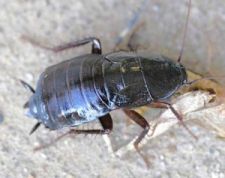 Description: Approximately 1 inch long and dark brown to black in color.
Description: Approximately 1 inch long and dark brown to black in color.
Habitat: The oriental cockroach is most common in dark, damp basements, but is known to climb water pipes to the upper floors of apartment houses.
Life Cycle: The female may carry the brown egg capsule for 30 hours with up to 16 eggs laid in the capsule. The average number of nymphs to hatch per egg capsule is 14.4. Each female deposits an average of eight capsules. The egg capsule is deposited in some warm sheltered spot where food is readily available. In this species the female cockroach gives no assistance to her newly born young. At room temperature, the incubation period averages 60 days. The developmental period for the oriental cockroach is 12 months, during which the insect undergoes 7 molts. The adults appear in May, June, and July, and the nymphs are more and more evident during summer months. Adults usually do not mature during the months of October, November, and December.
Symptoms: The oriental cockroach is less wary and more sluggish than other cockroaches. It often travels through sewer pipes and lives on filth. It may enter the home in food packages and laundry, or merely come in under the door or through air-ducts or ventilators. This cockroach prefers to feed upon starchy foods.
Smokybrown Cockroach
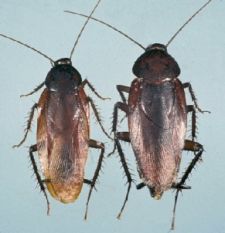 Habitat: Smokybrown cockroaches are prevalent in leaf litter, in and around shrubs, flowers and trees, tree holes, wood piles, garages, crawl spaces, attics, and greenhouses. It has also been found on roofs and in rain gutters feeding on bird droppings and plant materials. Smokybrown cockroaches can also survive in sewers.
Habitat: Smokybrown cockroaches are prevalent in leaf litter, in and around shrubs, flowers and trees, tree holes, wood piles, garages, crawl spaces, attics, and greenhouses. It has also been found on roofs and in rain gutters feeding on bird droppings and plant materials. Smokybrown cockroaches can also survive in sewers.
Life Cycle: The smokybrown cockroach life cycle requires about 320 days from egg to adult. The eggs are laid in an ootheca that is 1/2 inch long and is dark brown in color. Incubation averages 45 days. An average of 20 nymphs hatch from each ootheca. Adults live 2-6 months and are strong fliers attracted to lights at night.